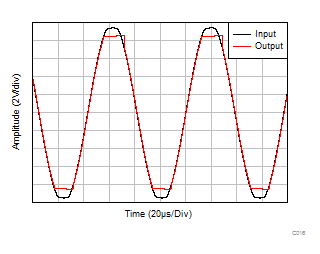SBOSAJ3 June 2024 TLV9104-Q1
PRODMIX
- 1
- 1 Features
- 2 Applications
- 3 Description
- 4 Pin Configuration and Functions
- 5 Specifications
- 6 Detailed Description
- 7 Application and Implementation
- 8 Device and Documentation Support
- 9 Revision History
- 10Mechanical, Packaging, and Orderable Information
Package Options
Mechanical Data (Package|Pins)
- PW|14
Thermal pad, mechanical data (Package|Pins)
Orderable Information
6.3.2 Phase Reversal Protection
The TLV910x-Q1 family has internal phase-reversal protection. Many op amps exhibit a phase reversal when the input is driven beyond the linear common-mode range. This condition is most often encountered in noninverting circuits when the input is driven beyond the specified common-mode voltage range, causing the output to reverse into the opposite rail. The TLV910x-Q1 is a rail-to-rail input op amp, therefore the common-mode range can extend up to the rails. Input signals beyond the rails do not cause phase reversal. Instead, the output limits into the appropriate rail. Figure 6-2 shows this performance.
 Figure 6-2 No Phase Reversal
Figure 6-2 No Phase Reversal